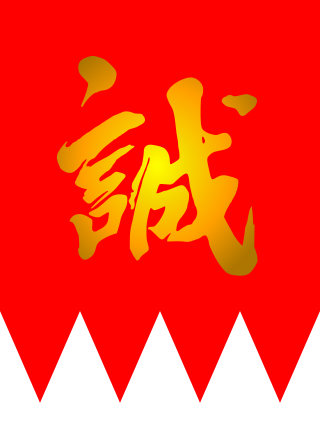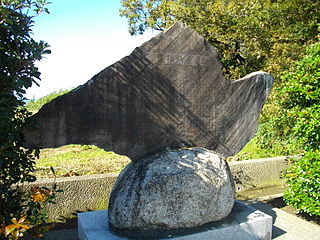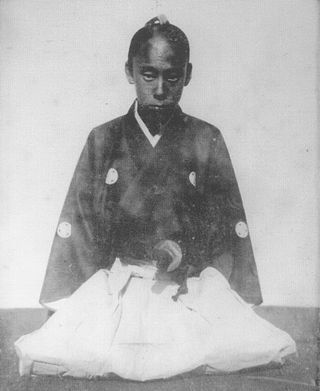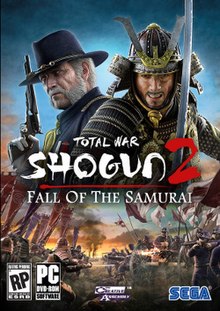
The Tokugawa shogunate, also known as the Edo shogunate, was the military government of Japan during the Edo period from 1603 to 1868.

The Boshin War, sometimes known as the Japanese Revolution or Japanese Civil War, was a civil war in Japan fought from 1868 to 1869 between forces of the ruling Tokugawa shogunate and a coalition seeking to seize political power in the name of the Imperial Court.

The Shinsengumi was a small elite group of swordsmen that was organized by commoners and low rank samurai, commissioned by the bakufu during Japan's Bakumatsu period in 1863. It was active until 1869. It was founded to protect the shogunate representatives in Kyoto at a time when a controversial imperial edict to exclude foreign trade from Japan had been made and the Chōshū clan had been forced from the imperial court. They gained considerable fame in the Ikedaya incident and the August 18 coup events, among others. The men were drawn from the sword schools of Edo.

Total War is a series of strategy games developed by British developer Creative Assembly for personal computers. They combine turn-based strategy and resource management with real-time tactical control of battles. Rather uniquely for real-time strategy games, flanking manoeuvers and formations factor heavily into gameplay. The first of the series, Shogun: Total War, was released in June 2000. The most recent major game released was Total War: Pharaoh on October 11, 2023. As of April 2021, the series had sold over 36 million copies.

Shogun: Total War is a turn-based strategy and real-time tactics video game developed by The Creative Assembly and published by Electronic Arts for Microsoft Windows personal computers. Released in June 2000, the game became the debut title in The Creative Assembly's Total War series. Set in Japan during Sengoku jidai—the "Warring States" period from the 15th to the beginning of the 17th century—the game has players adopt the leader of a contemporary Japanese clan, attempt to conquer the nation and claim the position of shōgun. The turn-based aspect of the game focuses on a map of Japan where military force, religion, diplomacy, espionage and economics all influence the player's actions, whilst battles are fought in a 3D real-time mode.

Medieval: Total War is a turn-based strategy and real-time tactics computer game developed by Creative Assembly and published by Activision. Set in the Middle Ages, it is the second game in the Total War series, following on from the 2000 title Shogun: Total War. Originally announced in August 2001, the game was released in North America on 19 August 2002 and in Europe on 30 August for Microsoft Windows.

The Satsuma Domain, briefly known as the Kagoshima Domain, was a domain (han) of the Tokugawa shogunate of Japan during the Edo period from 1602 to 1871.
Europa Barbarorum, or EB, is a modification of the PC game Rome: Total War (RTW) based on the desire to provide Rome: Total War players with a more historically accurate game experience.

Jōzai Domain was a feudal domain under the Tokugawa shogunate of Edo period Japan, located in Kazusa Province, Japan. The domain was centered on Manube jin’ya, in what is now the city of Kisarazu, Chiba. It was ruled for the entirety of its history by a branch of the Mizuno clan. Relatively small in size, it played an important role at the end of its existence, during the Boshin War of the Meiji Restoration.

The Kiheitai was a volunteer militia raised by Takasugi Shinsaku of the Chōshū domain during the Bakumatsu period of Japan.

Warhammer 40,000: Dawn of War – Dark Crusade is the second expansion to the real-time strategy video game Warhammer 40,000: Dawn of War developed by Relic Entertainment and published by THQ. Based on Games Workshop's tabletop wargame, Warhammer 40,000, Dark Crusade was released on October 9, 2006. The expansion features two new races, the Tau Empire and the Necrons. Including the Imperial Guard from Dawn of War's first expansion pack Winter Assault, a total of seven playable races in this expansion.

Tendō Domain was a feudal domain in Edo period Japan, located in Dewa Province, Japan. It was centered in what is now the city of Tendō, Yamagata. Tendō was ruled by the tozama Oda clan, direct descendants of the famed Oda Nobunaga, throughout its history. Although styled with the honorific of "castle", the clan residence was in fact a jin'ya, or fortified house.

Matsudaira Sadaaki was a Japanese daimyō of the Bakumatsu period, who was the last ruler of the Kuwana Domain. Sadaaki was the adopted heir of Matsudaira Sadamichi, the descendant of Sadatsuna, the third son of Hisamatsu Sadakatsu (1569–1623), who was Tokugawa Ieyasu's brother. His family was known as the Hisamatsu Matsudaira clan. It was to this family that Matsudaira Sadanobu also belonged.

Nabeshima Naomasa was the 10th and final daimyō of Saga Domain in Hizen Province, Kyūshū, Japan. His honorary title was Hizen-no-Kami, and he was occasionally referred to as “Prince Hizen” in western accounts during the Bakumatsu period.

Total War: Shogun 2 is a strategy video game developed by Creative Assembly and published by Sega in 2011. It is the seventh mainline entry in the Total War series and returns to the setting of the first Total War game, Shogun: Total War, after a series of games set mainly in Europe and the Middle East.

Total War: Rome II is a strategy video game developed by Creative Assembly and published by Sega. It was released on 3 September 2013, for Microsoft Windows as the eighth standalone game in the Total War series of video games and the successor to the 2004 game Rome: Total War.
Ashikaga Domain was a feudal domain under the Tokugawa shogunate of Edo period Japan, located in Shimotsuke Province, Japan. It was centered on Ashikaga jin'ya in what is now part of the city of Ashikaga. Ashikaga was ruled through most of its history by a junior branch of the Toda clan.
Fukiage Domain was a feudal domain under the Tokugawa shogunate of Edo period Japan, located in Shimotsuke Province, Japan. It was centered on Fukiage jin'ya in what is now part of the city of Tochigi. Fukiage was ruled through all of its history by a junior branch of the Arima clan.

Iwamura Domain was a feudal domain under the Tokugawa shogunate of Edo period Japan, located in Mino Province in what is now the town of Iwamura, Gifu. It was centered around Iwamura Castle, and controlled parts of Mino and Suruga Provinces. Iwamura Domain was controlled by a number of fudai daimyō clans in the course of its history.

The Yamashiro ikki or Yamashiro kuni ikki was a confederacy that emerged in Japan's Yamashiro Province during the late 15th century. After the chaotic Ōnin War had weakened the Ashikaga shogunate's authority, feuding samurai armies fought for the control of provinces across Japan. In Yamashiro Province, local samurai and peasants formed an ikki league and rose up in 1485, successfully demanding the withdrawal of two rival warlord armies. The ikki members subsequently organized a new provincial government, defying both warlords as well as the Ashikaga shogun in nearby Kyoto. The Yamashiro ikki continued to operate until 1493, when a new invasion of samurai armies forced its members to reaccept the shogunate's authority. Regardless, Yamashiro Province remained largely under local control, and repeated local uprisings as well as protests continued until 1511.


















